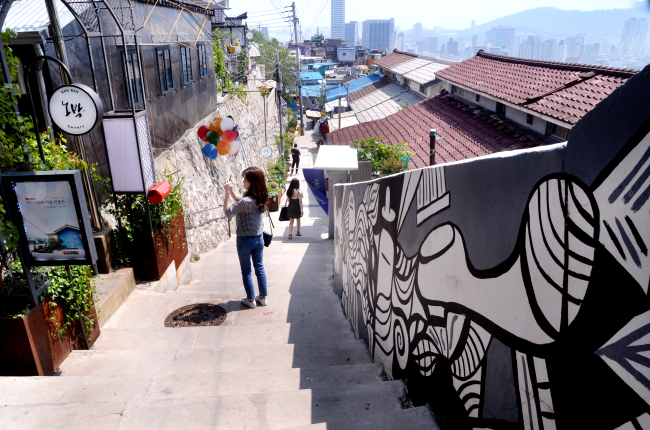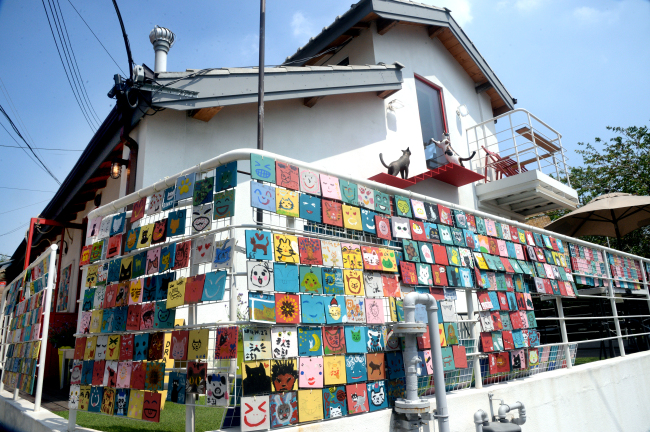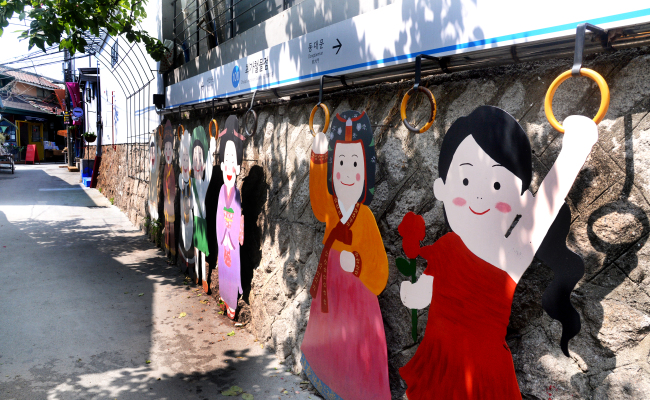[Seoul Saunter] Art brings life into historic Ihwa Mural Village
By Hong Dam-youngPublished : June 12, 2017 - 17:27
Perched at the top of Naksan is an old hillside community filled with steep stairways and narrow backstreets that are reminiscent of 1980s Korea.
Known as Ihwa Mural Village, the mountainside village offers visitors fresh air, expansive views of the city, and most importantly, an array of colorful paintings and sculptures that are hidden behind every corner.
The mural village, which is a 10-minute uphill walk from the bustling student district of Daehangno, has become one of the most frequented areas in Ihwa-dong in central Seoul, among both locals and international tourists.
Known as Ihwa Mural Village, the mountainside village offers visitors fresh air, expansive views of the city, and most importantly, an array of colorful paintings and sculptures that are hidden behind every corner.
The mural village, which is a 10-minute uphill walk from the bustling student district of Daehangno, has become one of the most frequented areas in Ihwa-dong in central Seoul, among both locals and international tourists.

Visitors can not only enjoy the artistic murals, but also relax at small museums, art galleries and coffee shops that are spread throughout the village. Music lovers can also enjoy a bite to eat at Jazz Story, a cozy coffee shop at the entrance of the village that boasts a classic collection of LPs.
“I visit the village when I need to clear my head,” said Lee Ju-hyun, a 22-year-old university student, who was taking a selfie with her friends against a wall adorned with colorful paintings.
“This village, detached from the noisy city, has the special power of bringing me peace. It’s not just about the artworks. I love the atmosphere here, which is so soothing and relaxing.”
While the village is now steeped in modern art, it was also home to some of Korea’s modern history. After the Korean War ended in 1953, the village housed war refugees, with some of their houses still standing today. Following the redevelopment of the area in the early 2000s, the neighborhood started to lose its vitality as residents left the aging village.
“I visit the village when I need to clear my head,” said Lee Ju-hyun, a 22-year-old university student, who was taking a selfie with her friends against a wall adorned with colorful paintings.
“This village, detached from the noisy city, has the special power of bringing me peace. It’s not just about the artworks. I love the atmosphere here, which is so soothing and relaxing.”
While the village is now steeped in modern art, it was also home to some of Korea’s modern history. After the Korean War ended in 1953, the village housed war refugees, with some of their houses still standing today. Following the redevelopment of the area in the early 2000s, the neighborhood started to lose its vitality as residents left the aging village.


To revitalize the historic area, the government embarked on an art project to transform the village into a cultural space in 2006. For about six months, citizens, college students and artists participated in redecorating the village’s walls, streets and staircases with vibrant paintings. The art project brought life back into the neighborhood and even made it a popular filming location for many TV shows and movies. About a year later, however, village residents requested that the murals be removed, citing disturbances by tourists who litter, make noise and paint graffiti.
In 2013, artists gathered again to redecorate the area, but they couldn’t stop five residents from pouring grey paint all over the most popular mural in the village called “flower staircase” last year. It was an old staircase renovated in 2013 with colorful tiles in the shape of flowers.
“The gap between the residents and visitors is slowly being fixed as the village has been thriving due to the artworks,” said Kang Doo-suk, the head of the village’s Welfare Center who has lived in the village for over 50 years.
“Now that the residents have started to see the village as a bridge between themselves and visitors, where both can benefit and stay happy.”
Some walls still display messages in red paint by disgruntled residents, such as “Please leave us alone,” but more residents are embracing the change, Kang said. Some of them are even opening galleries and cafes to coexist in the transforming community, he added.
In 2013, artists gathered again to redecorate the area, but they couldn’t stop five residents from pouring grey paint all over the most popular mural in the village called “flower staircase” last year. It was an old staircase renovated in 2013 with colorful tiles in the shape of flowers.
“The gap between the residents and visitors is slowly being fixed as the village has been thriving due to the artworks,” said Kang Doo-suk, the head of the village’s Welfare Center who has lived in the village for over 50 years.
“Now that the residents have started to see the village as a bridge between themselves and visitors, where both can benefit and stay happy.”
Some walls still display messages in red paint by disgruntled residents, such as “Please leave us alone,” but more residents are embracing the change, Kang said. Some of them are even opening galleries and cafes to coexist in the transforming community, he added.

Choi Hong-gyu, the director of the Lock Museum in Dongsung-dong near the village, is also at the front line of turning Ihwa Mural Village into the most artistically thriving community in Seoul. In 2013, Choi launched an annual event called “Ihwa-dong Village Museum Project” to narrow the gap between outsiders and residents. Tourists can look around museums and galleries in the neighborhood that showcase the village’s history and artifacts donated by the residents. Visitors can also rent old school uniforms that are given out by the residents and walk around the village in the vintage outfits, which is a part of the project’s various events.
Choi said he believes the neighborhood has more than just murals. Each elderly resident living here is a part of the cultural heritage, and the village has its own style and historic value.
“This is only the start of the 10-year project. It is true that some residents are still negative about the idea, but more of them are willing to be involved in the project,” Choi said.
“If I keep making an effort to bring people together with the project, I am pretty sure that in the next few years, the village will become the best neighborhood in Korea.”
This year’s Ihwa-dong Village Museum Project runs until June 25. For more information, visit http://ewhadong.com/.
Seoul is a vibrant megalopolis with modern high-rises crowding the city’s major arteries. Nestled among the gleaming buildings are maze-like alleys that appear to have escaped the passage of time. The Korea Herald explores the many nooks and crannies of Seoul, proclaimed the capital of Joseon in 1392, that reveal a multifaceted city. -- Ed.
By Hong Dam-young (lotus@heraldcorp.com)
Choi said he believes the neighborhood has more than just murals. Each elderly resident living here is a part of the cultural heritage, and the village has its own style and historic value.
“This is only the start of the 10-year project. It is true that some residents are still negative about the idea, but more of them are willing to be involved in the project,” Choi said.
“If I keep making an effort to bring people together with the project, I am pretty sure that in the next few years, the village will become the best neighborhood in Korea.”
This year’s Ihwa-dong Village Museum Project runs until June 25. For more information, visit http://ewhadong.com/.
Seoul is a vibrant megalopolis with modern high-rises crowding the city’s major arteries. Nestled among the gleaming buildings are maze-like alleys that appear to have escaped the passage of time. The Korea Herald explores the many nooks and crannies of Seoul, proclaimed the capital of Joseon in 1392, that reveal a multifaceted city. -- Ed.
By Hong Dam-young (lotus@heraldcorp.com)







![[KH Explains] Hyundai's full hybrid edge to pay off amid slow transition to pure EVs](http://res.heraldm.com/phpwas/restmb_idxmake.php?idx=644&simg=/content/image/2024/04/18/20240418050645_0.jpg&u=20240419100350)







![[From the Scene] Monks, Buddhists hail return of remains of Buddhas](http://res.heraldm.com/phpwas/restmb_idxmake.php?idx=652&simg=/content/image/2024/04/19/20240419050617_0.jpg&u=20240419175937)

![[KH Explains] Hyundai's full hybrid edge to pay off amid slow transition to pure EVs](http://res.heraldm.com/phpwas/restmb_idxmake.php?idx=652&simg=/content/image/2024/04/18/20240418050645_0.jpg&u=20240419100350)

![[Today’s K-pop] Illit drops debut single remix](http://res.heraldm.com/phpwas/restmb_idxmake.php?idx=642&simg=/content/image/2024/04/19/20240419050612_0.jpg&u=)